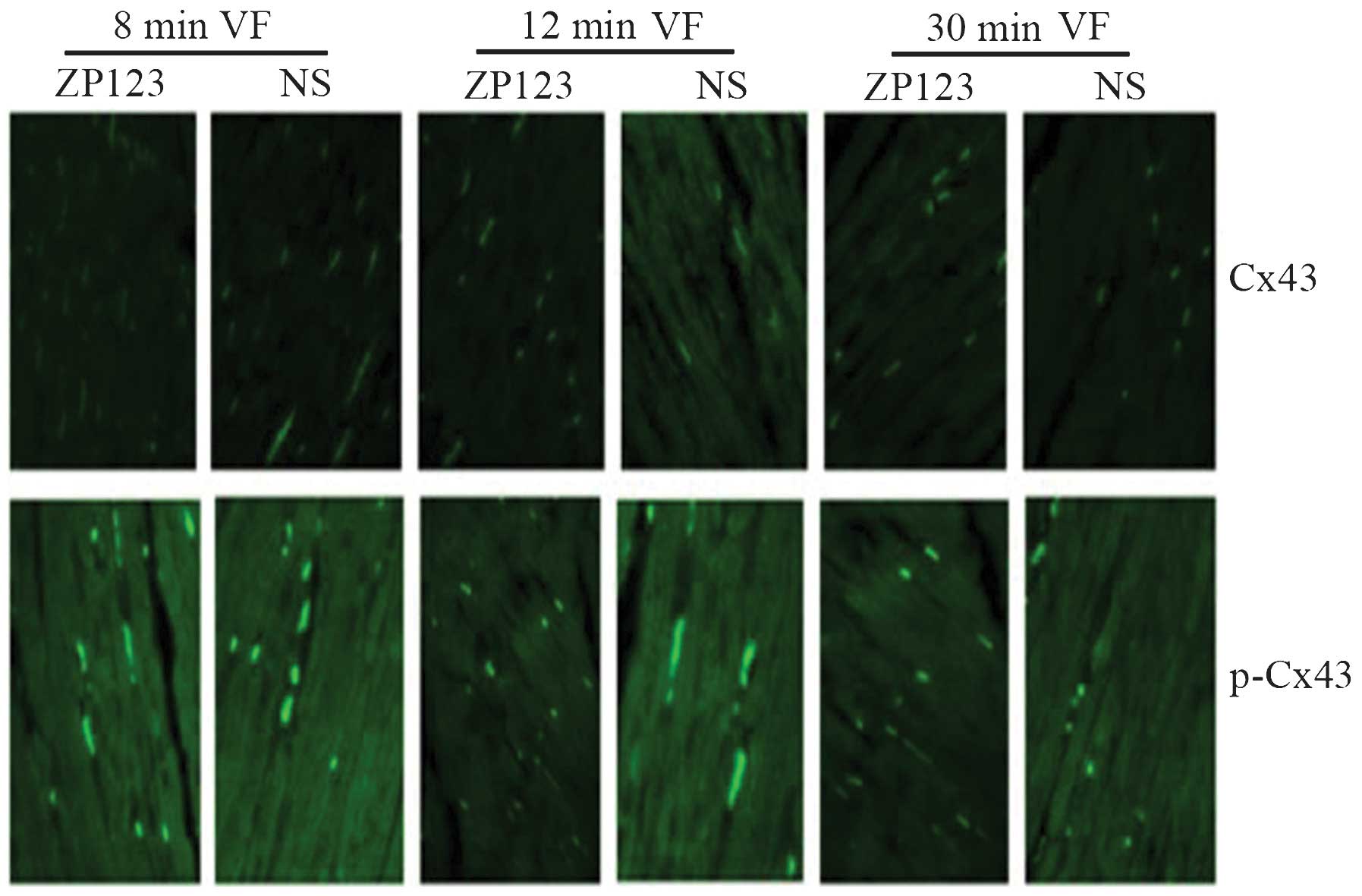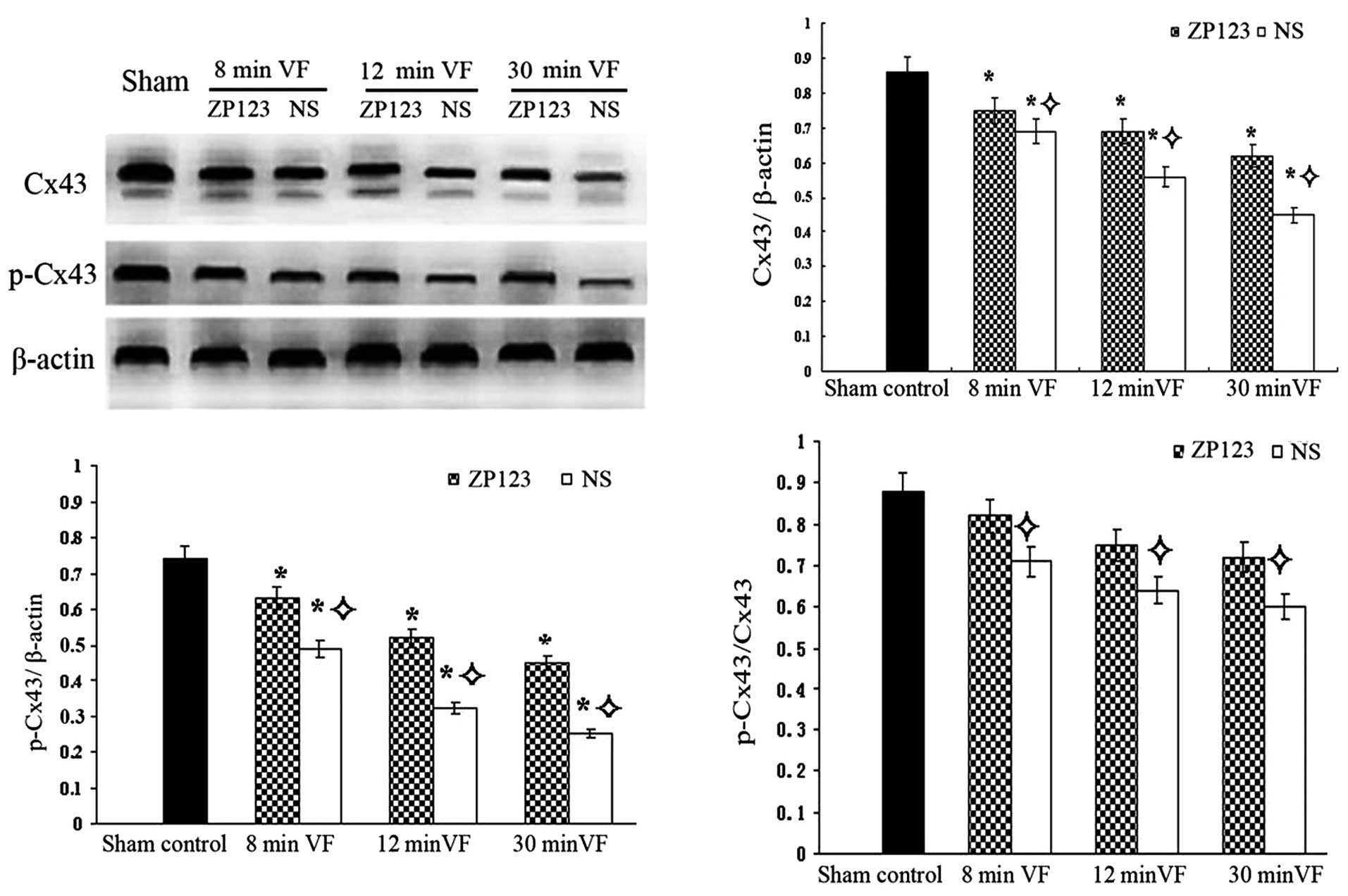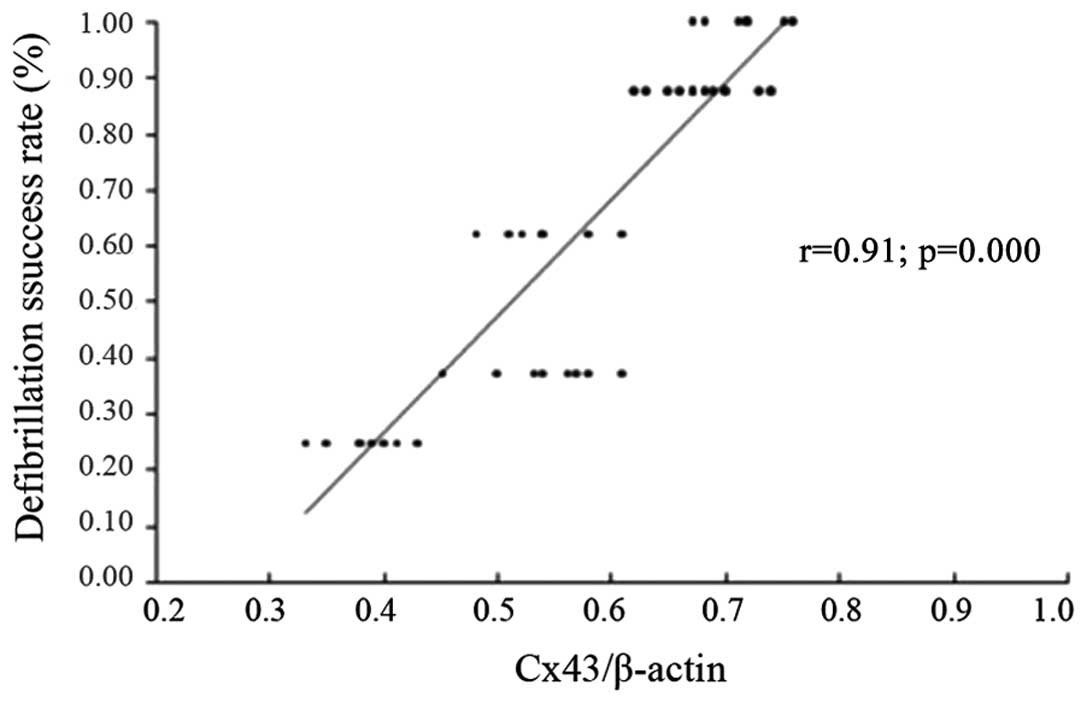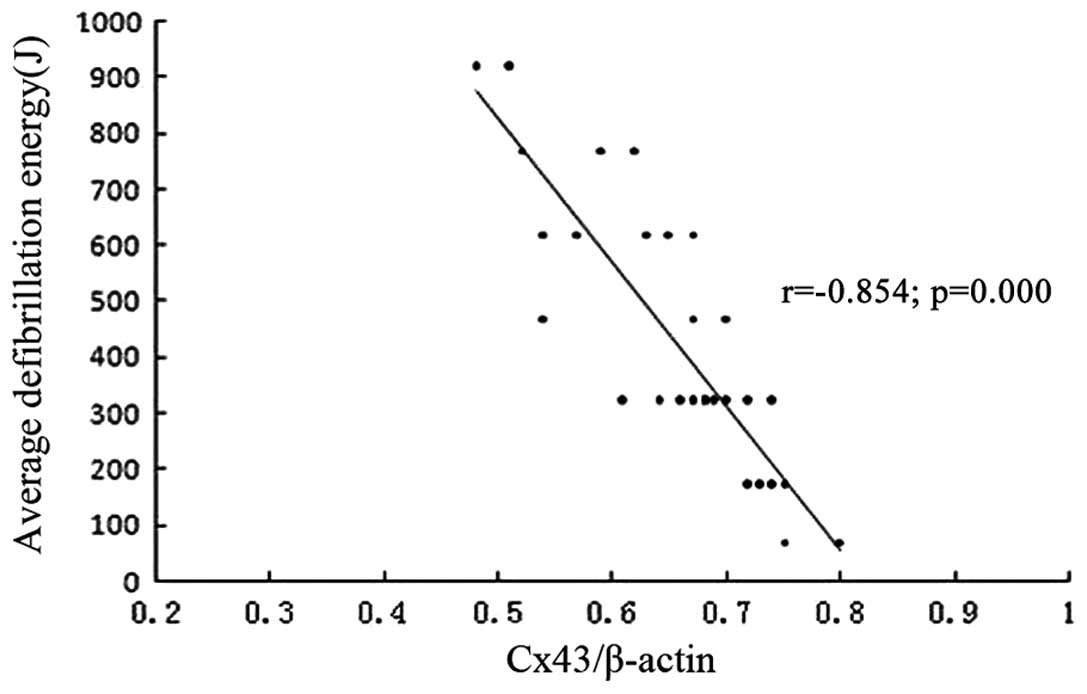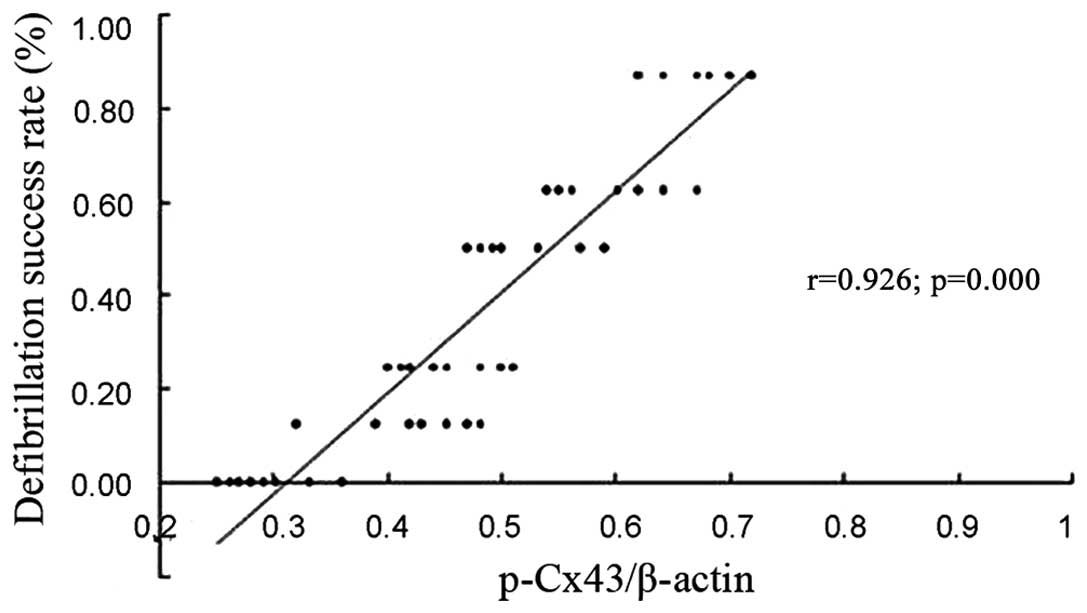Effects of rotigaptide (ZP123) on connexin43 remodeling in canine ventricular fibrillation
Corrigendum in: /mmr/12/6/8327
- Authors:
- Published online on: August 6, 2015 https://doi.org/10.3892/mmr.2015.4193
- Pages: 5746-5752
-
Copyright: © Su et al. This is an open access article distributed under the terms of Creative Commons Attribution License.
Abstract
Introduction
Ventricular fibrillation (VF) is one of the most common causes of sudden cardiac death (1). In recent years, along with the development of electrophysiological mapping techniques and in-depth research on cardiac fibrillation, the understanding of the mechanism of VF has greatly progressed (2,3). Re-entry is still considered to be the most important mechanism responsible for tachyarrhythmias (4,5). Conditions for re-entry include: i) The objective existence of an anatomical re-entry ring; ii) a unidirectional conduction block; iii) inconsistent conduction velocity and refractory period. For these three basic conditions, the refractory period is determined by the electrical activity of single cells. The spread of electrical activity from a single cell to its neighboring cells, thereby causing the synchronization of cardiac tissue excitability, is determined by the electrical coupling via gap junctions (GJ) between cells (6–8). GJs are important for the passive electrical activity of myocardial tissues.
There are two connection types between GJs: End-to-end and side-to-side. The structural basis for myocardial anisotropy depends on GJ connections. Normal myocardium is fusiform in arrangement and most GJs are end-to-end type at the long axis of the cardiomyocytes, with the lower junction resistance facilitating easy conduction of the ionic current and rapid electrical excitation. However, in the direction of the short axis, where GJs are of the side-to-side type, conduction of electrical excitation is slow and spreads in a 'zig-zag' style shape, causing increased probability of re-entry (9,10). In theory, the occurrence and maintenance of arrhythmias increase with the proportion of side-to-side GJs.
Connexins (Cx) are transmembrane proteins that assemble to form intercellular GJs. Reduced expression and abnormal distribution of Cx can slow down the overall cardiac conduction velocity and change conduction anisotropy, thereby forming the anatomical basis of a re-entrant loop that induces arrhythmia. In adult ventricles, GJs contain only Cx43 and are distributed mainly in the intercalated disk (11). Previous studies by our group have demonstrated that GJ remodeling caused by decreased expression and abnormal distribution of myocardial Cx43 is involved in the occurrence and maintenance of VF (12,13). Furthermore, a previous study by our group showed that the gap junction enhancer ZP123 can reduce or reverse the Cx43 degradation and derangement, thereby reducing defibrillation energy and improving cardioversion in VF (14).
In cardiomyocytes, only phosphorylated Cx43 (p-Cx43) constitutes a functional GJ and dephosphorylated Cx43 does not have this function (15). Therefore, the aim of the present study was to investigate changes in Cx43 phosphorylation and the effects of Z123 in cardioversion in an animal model of VF.
Materials and methods
Animal preparation
All animal care and experimental protocols received approval from the Animal Care and Use Committee of Qilu Hospital, Shandong University, (Jinan, China). Mongrel dogs (n=56, male or female, weighing 11–17 kg) were obtained from the Center for Experimental Animals of Qilu Hospital of Shandong University. Animals were randomly divided into seven groups (n=8/group): Sham control, 8-min VF + rotigaptide (ZP123; Shanghai Fuhe Chemistry Technology Co., Ltd., Shanghai, China), 8-min VF + normal saline (NS), 12-min VF + ZP123, 12-min VF + NS, 30-min VF + ZP123 and 30-min VF + NS. The three ZP123 groups were given ZP123 1 μg/kg bolus + 10 μg/kg/h by micropump (Perfusor Basic; B. Braun Melsungen AG, Melsungen, Germany) intravenous (iv) infusion for 30 min; the NS groups were given saline instead of ZP123. The animals were anesthetized with pentobarbital-Na (30 mg/kg iv, repetition when necessary; Merck Millipore, Darmstadt, Germany). After anesthesia, dogs were placed in the supine position and restrained at the four extremities. Animals were intubated with a 5.0 cuffed tracheal attached to a ventilator (Newport E-100M, Newport Medical Instruments, Costa Mesa, CA, USA). Ventilation began at a tidal volume of 10–15 ml/kg, with a ventilator rate of 16–20 breaths/min, and an inspiration to expiration ratio of 1:1.5–2.0. Three surface electrodes were placed separately under three limbs to correspond to standard lead II electrocardiogram (ECG). The right femoral artery and bilateral femoral veins were cannulated. 6-F catheters (Cordis Corp, Miami, FL, USA) were positioned in the intrathoracic ascending aorta and the right atrium under fluoroscopic guidance (CGO-3000; Beijing Wandong Medical Equipment,Beijing, China). The remaining cannulated femoral vein was used for drug infusion. Heparin (Shenzhen Hepalink Pharmaceutical Co., Ltd., Shenzhen, China) was administered at 100 U/kg for anti-coagulation, and added when necessary.
Creation of the VF model
VF was induced by delivering a 5-sec alternating current at 80 V across the thorax through two needles after the completion of drug delivery. Successful VF was defined as a decrease in aortic blood pressure below 25 mmHg and the presence of a VF waveform on the ECG. Dogs in the sham control group were anesthetized and intubated tracheally without the induction of VF. Untreated VF lasted for 8, 12 or 30 min in other groups. All measurements were performed by an investigator blinded to the experimental group assignment. At the end of the experimental protocol, the surviving animals were sacrificed by KCl (Tianjin XuanChi International Trade Co., Ltd., Tianjin, China) infusion.
Transthoracic echocardiography (TTE) study
Prior to VF and after return of spontaneous circulation (ROSC), all animals were examined by transeophageal echocardiography with a 2.5–3.5 MHz transducer (Philips Sonos 7500, Philips Corp, Eindhoven, The Netherlands) to measure the left atrium dimension (LAD), left ventricular diastolic dimensions (LVDd) and left ventricular ejection fraction (LVEF), in a parasternal long axis and M-mode view.
Hemodynamic measurements
Catheter positions were confirmed by X-ray fluoroscopy. Catheters in the intrathoracic ascending aorta and the right atrium were connected to the pressure transducers attached to a PRO EP recording system (PowerLab/16sp; AD Instruments, Sydney, Australia) by which aortic systolic pressure (AOSP), diastolic aortic pressure (AODP) and right atrial diastolic pressure (RADP) were recorded throughout the study. The coronary perfusion pressure (CPP) was calculated as AODP minus RADP and the mean aortic pressure (MAP) was calculated as 1/3 AOSP plus 2/3 AODP.
Cardiac arrest and defibrillation protocols
Cardiopulmonary resuscitation (CPR) was begun at the start of the VF period. All animals were given 2 min of CPR (chest compression rate, 100/min; chest compression-to-ventilation ratio, 30:2) prior to transthoracic countershock. If ROSC was not achieved, an immediate defibrillation using a 70-J biphasic shock was delivered by an external defibrillator (M4735; Philips). If ROSC was not achieved, another 2 min of CPR was performed immediately and the defibrillation energy was increased to a 100-J biphasic shock. If ROSC was still not achieved, this process was repeated with increased defibrillation energy (up to 150-J biphasic shock). The third CPR was continued until ROSC was achieved. If VF persisted, additional epinephrine (0.02 mg/kg) was administered and CPR was continued for 2 min with equal defibrillation energy (150-J biphasic shock)until the animals achieved ROSC or the entire rescue process reached 30 min. ROSC was defined as AOSP ≥80 mmHg, lasting for at least 1 min (16). The average defibrillation energy, defibrillation success rate, the success rate of the previous three defibrillations, ROSC and survival (1 h) rate were calculated.
Tissue collection
Samples of the left ventricular myocardium were collected within 15 sec of death and immediately snap-frozen in liquid nitrogen (stored at −80°C).
Western blot analysis
Myocardial membrane proteins were extracted by differential centrifugation (4°C; 1,000 × g for 10 min then 10,000 × g for 1 h). Equal amounts of protein from each sample were subjected to SDS-PAGE (10% polyacrylamide; EMD Millipore, Bedford, MA, USA) and transferred onto polyvinylidene difluoride (PVDF) membranes (EMD Millipore). The membranes were blocked for 2 h with 1% bovine serum albumin (cat. no. ST023; Huayan Biological Technology Co., Ltd., Shanghai, China) and then incubated overnight at 4°C with either rabbit polyclonal anti-Cx43 (cat. no. AB1727) or anti-p-Cx43 (cat. no. P3859Rb-p) diluted 1:400 (USCN Life, Wuhan, China). After being washed, membranes were incubated with horseradish peroxidase-conjugated goat anti-rabbit IgG secondary antibody diluted 1:2,000 (cat. no. sc-2004; Santa Cruz Biotechnology, Inc., Dallas, TX, USA) for 2 h. Immunoreactive bands were visualized with the SuperSignal West Pico enhanced chemiluminescence kit (Pierce, Rockford, IL, USA) according to the manufacturer's instructions. A monoclonal mouse antibody against β-actin (cat. no. A1978; Sigma-Aldrich, St. Louis, MO, USA) was used in every experiment as an internal control. Band intensities were quantified with Quantity One (Bio-Rad Laboratories, Inc. Hercules, CA, USA).
Immunofluorescence and confocal laser scanning microscopy of Cx43 and phosphorylated (p-)Cx43
Left ventricular preparations were fixed in 4% paraformaldehyde for 24 h. Tissue samples were embedded in paraffin (Santa Cruz Biotechnology, Inc., Santa Cruz, CA, USA), cut into 4-μm sections and mounted on gelatin-coated slides, prior to dewaxing, and rehydration with graded alcohols (Santa Cruz Biotechnology, Inc.). The slides were microwaved (700 watts for 15 min at 96°C) in boiling 0.01 M sodium citrate buffer (Santa Cruz Biotechnology, Inc.) for 15 min to enhance specific immunostaining. For blocking, a goat serum/phosphate-buffered saline (PBS; 1:20; Santa Cruz Biotechnology, Inc.) solution was added to the slides for 20 min at room temperature. The polyclonal rabbit anti-dog primary antibodies for Cx43 (AB1727; 1:100 dilution in PBS; EMD Millipore) and p-Cx43 (P3859Rb-p; 1:100 dilution in PBS; USCN Life Science, Inc., Wuhan, China) detection were added and slides were incubated overnight at 4°C. Finally, the slides were incubated in fluorescein isothiocyanate (FITC)-conjugated goat anti-rabbit secondary IgG antibody (sc-2012; 1:500 dilution; Santa Cruz Biotechnology, Inc.) for 30 min at 37°C. Samples were examined by laser scanning confocal microscopy (TCS SP2; Leica, Wetzlar, Germany). Primary antibodies were replaced with PBS in immunostaining controls. FITC excitation was performed at 488 nm and fluorescence was emitted at 519 nm. High-intensity signals were measured and analyzed with Image-Pro plus 6.0 software (Media Cybernetics, Inc., Rockville, MD, USA).
Statistical analysis
Values are expressed as the mean ± standard error of the mean. All variables were normally distributed and were analyzed by analysis of variance, correlation between variables was performed by linear correlation analysis, and non-normal distribution data were subjected to the rank correlation analysis, with P-values <0.05 considered to indicate statistically significant differences between values. Statistical analysis was performed with SPSS 13.0 (SPSS, Inc., Chicago, IL, USA).
Results
Baseline characteristics
There were no statistically significant differences among the animals in terms of body weight, heart rate, LAD, LVDd, LVEF and hemodynamic variables at baseline (Table I).
Comparison of TTE and hemodynamic index of animals achieving ROSC in the groups
Compared with the pre-VF values, LAD and LVDd in the 8-min and 12-min VF groups were significantly increased, while LVEF was significantly decreased (P<0.05). LAD and LVEF in the 12-min VF ZP123 and NS groups were different compared with those in the 8-min VF groups (P<0.05). The difference in LVDd among groups did not reach statistical significance. With the exception of RADP, all other hemodynamic indexes (AOSP, AODP, MAP and CPP) in the four groups were significantly lower than those prior to VF. Too few animals survived to determine any statistically significant differences between the 30-min VF groups (Table II).
Table IICharacteristics of animals which achieved return of spontaneous circulation in experimental groups. |
Comparison of defibrillation success rate, average defibrillation energy and survival rate among groups
Successful defibrillation was achieved in all eight animals in the 8-min VF + ZP123 group, including full ROSC and survival achieved during the first three defibrillations in seven of these animals. Successful defibrillation was achieved in seven animals in the 8-min VF + NS group, including four in the first three defibrillations and six in total achieving ROSC and survival for >1 h. Successful defibrillation was achieved in seven animals in the 12-min VF + ZP123 group, with five achieving ROSC and four surviving for >1 h. However, in the 12-min NS group, successful defibrillation was achieved in only five animals, with four achieving ROSC and three surviving for >1 h. Successful defibrillation was achieved in only two animals in the 30-min ZP123 group, although none but none survived, while successful defibrillation and survival was achieved in one animal in the 30-min NS group.
Statistical analysis showed that the success rates of the first three defibrillations in the 8-min and 12-min ZP123 groups were significantly higher than those in the NS control group (P<0.05), and the average defibrillation energy was significantly lower than that in the NS group (P<0.05). Although the difference in the ROSC and survival rates between the ZP123 and control groups did not reach statistical significance (P>0.05), the rates were higher in the three ZP123 treatment groups than those in the NS groups (Table III).
Immunofluorescence and western blot analysis results of Cx43 and p-Cx43
High-intensity specific immunoreactive signals for the detection of Cx43 and p-Cx43 were clearly identified with regular distribution in the ZP123 groups compared to those in the control groups. With the duration of VF, the Cx43 and p-Cx43 signals became progressively weaker with more irregular distribution (Fig. 1).
Western blot analysis showed that Cx43 expression in the VF groups was significantly lower than that in the sham control group (P<0.05). Cx43 expression was higher in the 12-min and 30-min ZP123 groups compared with that in the control groups (P<0.05), while no difference was detected in the 8-min groups. With the duration of VF, p-Cx43 expression decreased, while p-Cx43 in the ZP123 groups was significantly higher than that in the control groups (P<0.05). Furthermore, the ratio of p-Cx43/Cx43 decreased, while the p-Cx43/Cx43 ratio in the ZP123 groups was significantly higher than that in the control groups (P<0.05) (Fig. 2A–D).
Correlation analysis
Cx43 expression was positively correlated with the defibrillation success rate (r=0.91; P<0.01) (Fig. 3), and negatively with the average defibrillation energy (r=−0.854; P<0.01) (Fig. 4), while p-Cx43 expression correlated positively with the success rate of the first three defibrillations (r=0.926; P<0.01) (Fig. 5).
Discussion
The main finding of the present study was that pre-treatment with ZP123 reduced Cx43 remodeling through upregulation of Cx43 expression, downregulation of Cx43 dephosphorylation and by unifying the arrangement and distribution of Cx43 expression. These effects improved the electrical coupling between gap junctions, thereby reducing the defibrillation energy required for successful cardioversion (12). ~80% of cardiac arrests are caused by VF and although numerous types of anti-arrhythmic drugs have been evaluated, the therapeutic effects on ventricular tachycardia and VF arrhythmia are poor. Most traditional anti-arrhythmic drugs are myocardial cell membrane ion channel blockers, while some also have potential arrhythmogenic effects, and even increase mortality (17,18). Therefore, the identification of safer and more effective anti-arrhythmic drugs has become a focus of research in recent years.
ZP123 is a novel anti-arrhythmic peptide, which acts specifically on gap junctions (19,20). Although there are numerous studies on ZP123 and ventricular arrhythmias, the main focus has been on the prevention of acute myocardial infarction with re-entrant ventricular tachycardia and ischemic reperfusion arrhythmia (21–23). Studies on the effects of ZP123 on VF, particularly prolonged VF, are rare. A previous study by our group conducted in an 8-min VF model in pigs showed that ZP123 treatment upregulated Cx43 expression with a uniform arrangement and distribution (14). Another study by our group using a 4-min VF rabbit model confirmed the effects of ZP123 in reducing defibrillation energy without significant effects on hemodynamic and electrophysiological indicators, including systolic blood pressure, right atrial pressure, heart rate, QRS width, QT interval and one-way action potential (24).
In the present study, 8-min, 12-min and 30-min models of shock-induced VF were established in dogs. It was found that, compared with the NS control group subjected to the same VF process, ZP123 increased Cx43 expression in myocardial membranes, particularly the phosphorylated form (p-Cx43), while the disruption of Cx43 distribution was alleviated. In the ZP123 groups, Cx43 expression in the myocardial cell membrane increased with VF compared with that in the NS control group; however, despite the 8-min VF, the increase did not reach the level of statistical significance, possibly due to the small sample size. In addition, ZP123 lowered the defibrillation energy and improved the defibrillation success rate, particularly in the first three defibrillations, compared with that in the NS control group. A correlation was identified between Cx43 expression in myocardial cell membranes and the defibrillation energy and success rate (r=−0.854, 0.91; P<0.001). Specifically, increased Cx43 expression levels significantly reduced the defibrillation energy and improved defibrillation success rates. A significant correlation was also identified between the success rate of the first three cardiac defibrillations and p-Cx43 expression levels in the myocardial cell membrane (r=0.926; P<0.001), indicating that the cardiac defibrillation success rate is dependent on Cx43 phosphorylation.
The specific molecular and electrophysiological mechanism underlying the effects of ZP123 on GJs remain elusive. However, according to a previous study, ZP123 enhances electrical coupling between GJs in ventricular myocytes without affecting ion channels and accelerates conduction between cells while reducing the heterogeneity of myocardial cell repolarization, thus eliminating the effects generated by the arrhythmia (25).
In conclusion, the present study indicated that prolonged VF leading to myocardial ischemia, hypoxia and acidosis, can induce Cx43 remodeling and the loss of GJ coupling. These factors lead to slowing of the electrical conduction velocity and increased re-entry, which facilitate the maintenance of VF. ZP123 treatment upregulated the expression of Cx43, particularly the phosphorylated form, in cardiac cell membranes, and reduced the heterogeneity in Cx43 arrangement and distribution, thus alleviating the effects of myocardial GJ remodeling and enhancing GJ electrical coupling. Thereby, these effects reduced re-entry and improved cardiac electrical conduction velocity, thus facilitating cardioversion in VF. It can be speculated that the molecular mechanism underlying the ZP123-mediated reduction in defibrillation energy and improved defibrillation success rate are mediated through regulation of the expression of Cx43 and phosphorylated Cx43 in particular.
Acknowledgments
This study was sponsored by the Natural Science Foundation of China (no. 81270238) and the Scientific Research Foundation for the Doctoral Degree, State Education Ministry of China (no. 20100131110059), and supported by the Scientific Development Plan of Shandong Province of China (no. 2012G0021850).
References
|
Hovdenes J, Laake JH, Aaberge L, Haugaa H and Bugge JF: Therapeutic hypothermia after out-of-hospital cardiac arrest: experiences with patients treated with percutaneous coronary intervention and cardiogenic shock. Acta Anaesthesiol Scand. 51:137–142. 2007. View Article : Google Scholar | |
|
Osadchii OE: Mechanisms of hypokalemia-induced ventricular arrhythmogenicity. Fundam Clin Pharmacol. 24:547–559. 2010. View Article : Google Scholar : PubMed/NCBI | |
|
Bae JH, Park CW, Cho JH, Kim YS, Lee HY and Won MH: The potential mechanism of the detrimental effect of defibrillation prior to cardiopulmonary resuscitation in prolonged cardiac arrest model. Lab Anim Res. 30:79–83. 2014. View Article : Google Scholar : PubMed/NCBI | |
|
Langley P, MacGowan GA and Murray A: Spatial and temporal organization of the dominant frequencies in the fibrillating heart: body surface potential mapping in a rare case of sustained human ventricular fibrillation. Europace. 11:324–327. 2009. View Article : Google Scholar | |
|
Tribulová N, Knezl V, Okruhlicová L and Slezák J: Myocardial gap junctions: targets for novel approaches in the prevention of life-threatening cardiac arrhythmias. Physiol Res. 57(Suppl 2): S1–S13. 2008. | |
|
Chaldoupi SM, Loh P, Hauer RN, de Bakker JM and van Rijen HV: The role of connexin40 in atrial fibrillation. Cardiovasc Res. 84:15–23. 2009. View Article : Google Scholar : PubMed/NCBI | |
|
Axelsen LN, Haugan K, Stahlhut M, et al: Increasing gap junctional coupling: a tool for dissecting the role of gap junctions. J Membr Biol. 216:23–35. 2007. View Article : Google Scholar : PubMed/NCBI | |
|
Fialová M, Dlugosová K, Okruhlicová L, Kristek F, Manoach M and Tribulová N: Adaptation of the heart to hypertension is associated with maladaptive gap junction connexin-43 remodeling. Physiol Res. 57:7–11. 2008. | |
|
Lee PJ and Pogwizd SM: Micropatterns of propagation. Adv Cardiol. 42:86–106. 2006. View Article : Google Scholar : PubMed/NCBI | |
|
van Rijen HV, de Bakker JM and van Veen TA: Hypoxia, electrical uncoupling, and conduction slowing: Role of conduction reserve. Cardiovasc Res. 66:9–11. 2005. View Article : Google Scholar : PubMed/NCBI | |
|
Moffitt JA, Henry MK, Welliver KC, Jepson AJ and Garnett ER: Hindlimb unloading results in increased predisposition to cardiac arrhythmias and alters left ventricular connexin 43 expression. Am J Physiol Regul Integr Comp Physiol. 304:R362–R373. 2013. View Article : Google Scholar : PubMed/NCBI | |
|
Yi SL, Zhong JQ, Zhang J, Su GY, Li JS, Liu HZ and Zhang Y: ZP123 reduces energy required for defibrillation by preventing connexin43 remodeling during prolonged ventricular fibrillation in swine. Tex Heart Inst J. 39:784–791. 2012. | |
|
Li JS, Zhong JQ, Zeng QX, Liu HZ, Su GY and Zhang Y: Effect of ZP123, a gap junction modifier, on prolonged ventricular fibrillation in swine. Cardiology. 118:147–152. 2011. View Article : Google Scholar : PubMed/NCBI | |
|
Liu HZ, Zhong JQ, Li JS, Su GY, Wang J and Zhang Y: Changes in myocardial connexin 43 during ventricular fibrillation. Zhongguo Wei Zhong Bing Ji Jiu Yi Xue. 22:595–598. 2010.In Chinese. PubMed/NCBI | |
|
Salameh A and Dhein S: Adrenergic control of cardiac gap junction function and expression. Naunyn Schmiedebergs Arch Pharmacol. 383:331–346. 2011. View Article : Google Scholar : PubMed/NCBI | |
|
Sattur S and Kern KB: Increasing CPR duration prior to first defibrillation does not improve return of spontaneous circulation or survival in a swine model of prolonged ventricular fibrillation. Resuscitation. 80:382author reply 382–383. 2009. View Article : Google Scholar | |
|
Echt DS, Liebson PR, Mitchell LB, et al: Mortality and morbidity in patients receiving encainide, flecainide, or placebo. The Cardiac Arrhythmia Suppression Trial. N Engl J Med. 324:781–788. 1991. View Article : Google Scholar : PubMed/NCBI | |
|
Waldo AL, Camm AJ, deRuyter H, et al: Effect of d-sotalol on mortality in patients with left ventricular dysfunction after recent and remote myocardial infarction. The SWORD Investigators. Survival With Oral d-Sotalol. Lancet. 348:7–12. 1996. View Article : Google Scholar : PubMed/NCBI | |
|
Dhein S, Larsen BD, Petersen JS and Mohr FW: Effects of the new antiarrhythmic peptide ZP123 on epicardial activation and repolarization pattern. Cell Commun Adhes. 10:371–378. 2003. View Article : Google Scholar : PubMed/NCBI | |
|
Xing D, Kjølbye AL, Petersen JS and Martins JB: Pharmacological stimulation of cardiac gap junction coupling does not affect ischemia-induced focal ventricular tachycardia or triggered activity in dogs. Am J Physiol Heart Circ Physiol. 288:H511–H516. 2005. View Article : Google Scholar : PubMed/NCBI | |
|
Xing D, Kjølbye AL, Nielsen MS, et al: ZP123 increases gap junctional conductance and prevents reentrant ventricular tachycardia during myocardial ischemia in open chest dogs. J Cardiovasc Electrophysiol. 14:510–520. 2003. View Article : Google Scholar : PubMed/NCBI | |
|
Haugan K, Marcussen N, Kjølbye AL, Nielsen MS, Hennan JK and Petersen JS: Treatment with the gap junction modifier rotigaptide (ZP123) reduces infarct size in rats with chronic myocardial infarction. J Cardiovasc Pharmacol. 47:236–242. 2006. View Article : Google Scholar : PubMed/NCBI | |
|
Hennan JK, Swillo RE, Morgan GA, et al: Rotigaptide (ZP123) prevents spontaneous ventricular arrhythmias and reduces infarct size during myocardial ischemia/reperfusion injury in open-chest dogs. J Pharmacol Exp Ther. 317:236–243. 2006. View Article : Google Scholar | |
|
Zhong JQ, Laurent G, So PP, Hu X, Hennan JK and Dorian P: Effects of rotigaptide, a gap junction modifier, on defibrillation energy and resuscitation from cardiac arrest in rabbits. J Cardiovasc Pharmacol Ther. 12:69–77. 2007. View Article : Google Scholar : PubMed/NCBI | |
|
Eloff BC, Gilat E, Wan X and Rosenbaum DS: Pharmacological modulation of cardiac gap junctions to enhance cardiac conduction: evidence supporting a novel target for antiarrhythmic therapy. Circulation. 108:3157–3163. 2003. View Article : Google Scholar : PubMed/NCBI |



